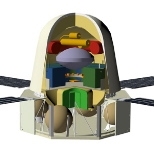Students and researchers at MIT are designing a space mission to learn about the effects of Mars-level gravity using pint-sized astronauts.
The 15 "mouse-tronauts" will orbit Earth for five weeks to help researchers learn how Martian gravity--about one-third that of Earth--will affect the mammalian body.
The goal of the Mars Gravity Biosatellite Program is to send the mice into near-Earth orbit inside a one-meter space ship simulating Mars' gravity, then bring them back to Earth. It won't be the first time mice have flown in space, but it will be the first time mammals of any kind have lived in partial gravity for an extended period. The spin of the spacecraft will create an effect on the mice equivalent to Mars' gravity.
The mouse cages will be designed for comfort and protection with room for the little travelers to lope around for exercise in the simulated gravity of Mars.
"Astronauts living on space stations have encountered serious health problems such as bone loss due to their weightless environment [zero gravity]," the team said in a statement. "The first crew on Mars could experience similar effects; scientists do not yet know whether partial gravity is sufficient to prevent these health hazards. A crew of mice will provide the first answers."
The multi-university group, led by MIT and involving the University of Washington at Seattle and the University of Queensland in Brisbane, Australia, is managed by MIT research affiliate Paul Wooster (S.B. 2003).
The MIT team is providing overall systems engineering and project management, designing and building the payload module and planning the scientific experiments. Students and researchers from Washington are designing and building the spacecraft bus, which contains the power, propulsion and communications components. Re-entry and recovery systems are the responsibility of the Australian group.
The project is expected to cost about $15 million plus the cost of the launch. The teams have received more than $400,000 for building the spacecraft from a variety of sources including NASA, the three universities, and private companies and individuals. The teams have also secured commitments to cover approximately half the $6 million launch cost.
The program is overseen by a program board composed of faculty from each of the universities and outside space experts, and supported by a broad network of advisers from the space field. Given appropriate funding, the mission could launch as early as mid-2006.
For more information on the Mars Gravity Biosatellite, visit http://www.marsgravity.org.
A version of this article appeared in MIT Tech Talk on January 14, 2004.






